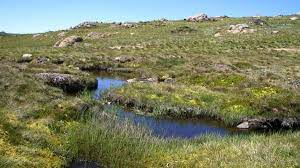Peatlands : New Study

A new study finds that canals used to drain soggy peatlands in Southeast Asia are likely hotspots for greenhouse gas emissions.
- Peatlands are terrestrial wetland ecosystems in which waterlogged conditions prevent plant material from fully decomposing.
- Consequently, the production of organic matter exceeds its decomposition, which results in a net accumulation of peat.
- These occur in every climatic zone and continent and cover around 2.84% of the Earth’s terrestrial surface.
- The majority of the world’s peatlands occur in boreal and temperate parts of the Northern Hemisphere, especially, Europe, North America, and Russia, where they have formed under high precipitation-low temperature climatic regimes.
- About 84% of the world’s peatlands are considered to be in natural, or near-natural state.
- Drained peatlands make up about 16% of the world’s peatlands, or 0.5% of the Earth’s terrestrial surface.
- Due to the process of peat accumulation, peatlands are carbon rich ecosystems. Peatlands are the largest natural terrestrial carbon store.
- They store more carbon than all other vegetation types in the world combined.
- Damaged peatlands are a major source of greenhouse gas emissions, responsible for almost 5% of global anthropogenic CO2 emissions.




